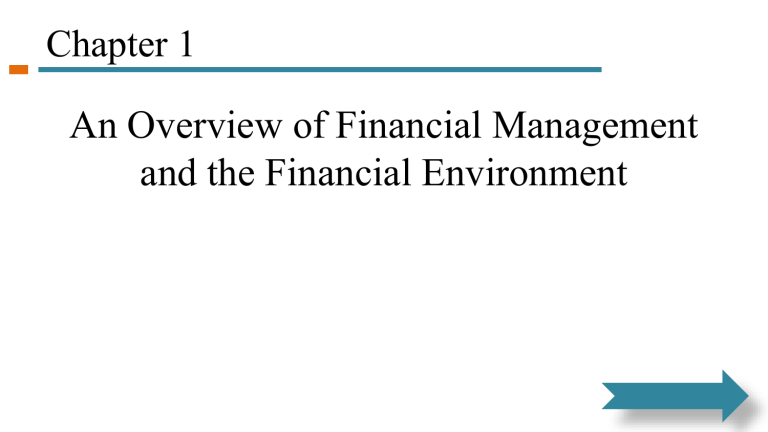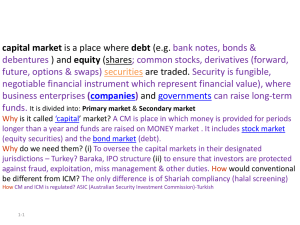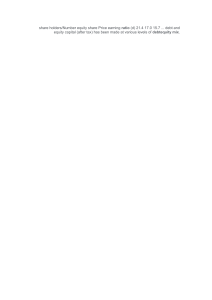
Chapter 1 An Overview of Financial Management and the Financial Environment Contents in Chapter The Corporate life cycle: Forms of business organization The objective of the firm: Maximizing stockholder wealth Determinants of fundamental value: Intrinsic value Financial securities, markets and institution Attributes of successful companies Skilled people Strong relationship Enough funding The Corporate Life Cycle Sole proprietorship Partnership Corporation Starting Up as a Proprietorship Advantages Easy and inexpensive to start Relatively few government regulations No corporate income tax on profits Disadvantages Limited to obtain the funding Unlimited personal liability Limited life More Than One Owner: A Partnership A partnership has roughly the same pros and cons as a sole proprietorship Many Owners: A Corporation A legal entity created under state laws It is separate and distinct from its owners and managers Advantages Unlimited life Easy transfer of ownership Limited liability Disadvantages Double taxation Cost of set-up and time-consuming for report filling --Could you give any discussion relating to the double taxation?-- Growing a Corporation: Going Public Raises cash by selling their stock to the general public listed stock on stock exchange by registering Going public is called an initial public offering (IPO) Investment bank has a brokerage firm which employs brokers on behalf of clients Subsequent issues of debt and equity Primary Objective of the Firm The primary objective is shareholder wealth maximization, which translates to maximizing the fundamental stock price. Stock Vs. Share Managing a Corporation’s Value What determines a corporation’s value? “It is a company’s ability to generate cash flows now and in the future.” Free Cash Flow • Free cash flows are the cash flow that are available (or free) for distribution to all investors (stockholders and creditors) • FCF = Sales revenues - Operating costs - Operating taxes - Required investments in new operating capital Weighted Average Cost of Capital (WACC) WACC is the average rate of return required by all of the company’s investors It is also called as discount rate It is a cost from company’s point of view Weighted Average Cost of Capital (WACC) Cont. WACC is affected by: Capital structure (the firm’s relative use of debt and equity as sources of financing) Interest rates Risk of the firm Investors’ overall attitude toward risk Determining a firm’s fundamental, or intrinsic, value Intrinsic value is the sum of all the future expected free cash flows when converted into today’s cash Figure: Determinants of Intrinsic Value An Overview of Financial Markets Providers and users of cash into four groups: Individual, Financial organizations (like banks and insurance companies), Non financial organizations (like Apple, Starbucks, and Ford), and Governments Providers (Savers) and Users (borrowers) The Capital Allocation Process Getting Cash from Providers to Users: The Capital Allocation Process Transfers of capital from providers to users take place in three different ways Direct transfer Through an investment banking house Through a financial intermediary Type of Claim on Future Cash Flows: Debt and Equity Debt Debt instruments typically have specified payments and a specified maturity If debt matures in more than a year, it is called a capital market security If the debt matures in less than a year, it is a money market security Equity Equity instruments are a claim upon a residual value Stock has no maturity date, it is a capital market security. Fundamental Factors That Affect the Required Rate of Return (the Cost of Money) production opportunities, time preferences for consumption, risk, and Expected inflation Economic Conditions and Policies That Affect the Required Rate of Return (the Cost of Money) • Federal Reserve Policy • Budget deficits/ surplus • Level of Business Activity (recession or boom) • Foreign Trade Balance : deficits/surplus (level of imports to export) The Functions of Financial Institutions Investment Banks and Brokerage Activities It helps companies raise capital (1) advise corporations regarding the design and pricing of new securities, (2) buy these securities from the issuing corporation, and (3) resell them to investors. Deposit-Taking Financial Intermediarie • Savings and Loan Associations (S&Ls) • Credit Unions • Commercial banks Investment Funds • Mutual Funds (managing portfolios, and buying/ selling securities) • Hedge Funds • Private equity fund whereas hedge funds usually own many types of securities. In contrast to a mutual fund, which might own a small percentage of a publicly traded company’s stock, a private equity fund typically purchases the entire company. Life Insurance Companies and Pension Funds • Life insurance companies take premiums, invest these funds in stocks, bonds, real estate, and mortgages, and then make payments to beneficiaries • Life insurance companies also offer a variety of taxdeferred savings plans designed to provide retirement benefits. Traditional pension funds are retirement • Traditional pension funds are retirement plans funded by corporations or government agencies Financial Markets • Physical Assets versus Financial Assets • Time of Delivery: Spot (within a few days versus Future (6 months or year) • Maturity of Financial Asset: Short (money) versus Long (capital) • Primary Markets versus Secondary Markets – new capital in primary market – Existing securities in secondary market Trading Procedures in the Secondary Markets • Physical Location versus Electronic Network • Matching Orders: Open Outcry Auctions, Dealer Markets, and Automated Trading Platforms – automated matching engine : part of a computer system – automated trading platform (entire system) End!





